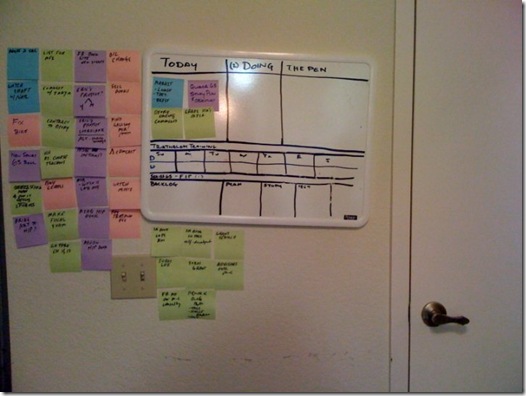In Personal Kanban we have only two rules. One of them is to limit your WIP.That sounds simple enough. But what does limiting your WIP really imply?This series describes what we mean by "WIP," why it's important to limit it, and - with all the competing demands on our time - how we can begin to go about doing just that.
WIP = Work-in-Progress
WIP is an acronym for "work-in-progress." It's the proverbial "stuff on your plate," the "balls you are juggling." It's the work you've begun and currently have in process.Now consider those things in your life that can and will at some point constitute your WIP: deliverables you have at the office, improvement projects piling up at home, monthly bills that need tending to, doctors appointments that need scheduling, phone calls that need returning. Now take into account the things you enjoy doing (but that often get put on the back burner), like taking a photography class or working on your yoga practice. Things you both need and want to accomplish can add up to a huge number of tasks you have to hold in your head simultaneously.Some of these tasks are fairly low-impact. Others are more challenging and might require additional attention.We want to limit the number of active tasks we juggle because we have a "capacity" - a maximum amount of work we can process at a given time. We simply cannot do more work than we can handle.
What Happens When We Don’t Limit WIP
When we exceed the amount of work we can handle, it heightens our distraction and decreases our concentration. Our attention to detail suffers, we leave things unfinished, or compromise the quality of our finished product. All of these outcomes create more work or us in the future.
Forgetting
When we forget something - whether it entails leaving out important details or missing a deadline - invariably someone else will point out our misstep. When they do, a conversation (most likely a pointed one) often ensues. Addressing and compensating for missteps takes time and effort, compounding cost, and ultimately frustration.
Leaving Things Unfinished
When we leave things incomplete we have two outcomes: (1) We never finish them or (2) We finish them later.For case (1) it's likely we've wasted time, effort, and resources.In case (2) we return to the task at a later date, when the task's context (its need, impact, or resources available) might have changed. Oftentimes that requires looking at the task and figuring out exactly where we left off, why we made the decisions we did, and what – exactly – was our preferred course to completion. This reorienting process of remembering and reorganizing likewise can consume time, and incur additional effort and resources.
Compromising Quality
A job poorly executed is sometimes worse than a job left incomplete. When work is done poorly, it usually contains defects. When defects become work multipliers, there are consequences down the line: defects can slow work down, break something else, or even hurt someone. Or they might just make your work product less helpful than it could have been had proper care been taken initially. If your defect is deemed serious enough to require repair (in essence, doing your work over again), first that defect must be discovered, then appreciated, then discussed, then deemed worthy of repair, then the repair needs to be identified, then acted upon.And those are the easy ones.When we compromise the quality of our work, we don’t just “do a bad job,” we leave someone to clean up an expensive and time consuming mess.
What Happens When We Do Limit WIP
We'd like to say that limiting WIP will solve all these problems, but it won’t. Nothing makes these things go away entirely.However, not limiting WIP means we are pretty much guaranteed to fall victim to these time wasters, and we are guaranteed to do it often.When we limit our WIP, we have less distractions. We are able to focus on correct decisions, completion, and quality.When we set a WIP limit, we are telling ourselves and the world around us that we want to get work done quickly, and we want to do a quality job.Even though prioritizing some tasks over others means some tasks have to wait, those tasks will still be completed sooner than they would have if we started them all right away. Since we are no longer paying the penalties for forgetting, incompletion, or poor quality, the work we finish is done faster and does not cause additional work.
What’s Next
This is just the tip of the iceberg as to why we should limit WIP. Over the upcoming months, we will be releasing more benefits to both Limiting Your WIP and Visualizing Your Work.Until then, there are other related resources on this site. Simply check out articles tagged “WIP,” or visit the PK 101 page.










